This week, I am still in Amsterdam, and it’s also October, which means scary movies are on the agenda. Based on what I had available, I picked two of my favorite Japanese horror films. This weeks films are:
Kaneto Shindo – Kuroneko (1968)
Nobuhiko Obayashi – House (1977)
I’ve seen both of these films before, I both I find really interesting and enjoyable. Kuroneko is a moody ghost story, while House is a totally bonkers haunted house story. they also both prominently feature cats.
Let’s get into it.
Kuroneko (1968)
A woman and her daughter-in-law are attacked by fleeing soldiers in their home, who rape them and burn their house down. Years later, samurai begin mysteriously dying on a particular road. A returning samurai named Gintoki is tasked with discovering what’s happening to them. But when he discovers the truth, will he be able to do anything about it?

The film is directed by Kaneto Shindo, and while I don’t recognize anything else on his filmography, but he had a long, successful career. The actors in the film likewise wouldn’t be recognizable to American audiences. The title Kuroneko means “Black Cat” in English, and a black cat plays a prominent role in the mythos of the film. I’m not totally sure how the cat fits into Japanese history or religion or mythology, but it almost seems like the cat is used as a shorthand for some kind of evil spirit.
The tone of the film is dark, spooky, and melancholy. All the characters in this film are having a bad time. The cinematography adds to this, as shadows are an important part of the sets. If the film wasn’t placed so firmly in the horror genre, we might be able to analyze it as a noir. It also uses various camera tricks to play with our expectations. In one scene, to indicate that things are not as they appear, we see a normal home, but above it a series of bamboo trunks which are moving at a completely different speed.

We start out with the rape scene, which is intense and uncomfortable. It stops just short of being graphic, but it successfully conveys how horrifying the experience is for the women. A group of a dozen men enter their home, shove the women around, steal their food, and then take turns. All the other men watch while it’s happening. At some point during the experience the women pass out, and on the way out of the hut, one of the men sets fire to the hut, and the women don’t wake up.
After it burns down, we see the two women lying there, unburned, but seemingly dead. A black cat wanders in and begins walking over their bodies meowing, and licking their wounds. This is the last we see of the women until the next scene, which occurs at night. We see a sleepy samurai on horseback riding along, and a figure in white is following him. The film gives ample evidence that it’s a supernatural figure by the way it somersaults over the man without him noticing.
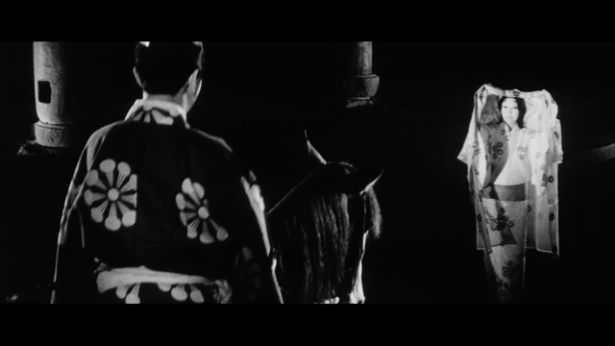
Finally, he comes up to the Rajomon gate and sees a woman dressed all in white, asking for his help crossing the grove of bamboo ahead. He jokes that she must be a spirit, but she laughs it off. It eventually becomes clear that this is Shige, the woman who was raped and murdered along with her mother-in-law Yone. But at this point. we’ve only seen their faces for a very brief scene, and here she is in completely different clothes and makeup.
The samurai agrees to take her home, and when she gets there, she invites him in for sake with her mother-in-law. He agrees after some hesitation and in the home Shige sits down with him to listen to his stories, and Yone brings him some sake. They serve him cup after cup. While this scene is playing out, several strange things happen. Yone appears and disappears when the samurai turns away, we see Yone’s hair swish like a cat’s tail, and Shige’s hand briefly turns into a black cat’s paw when she pours the samurai another sake.

Eventually, Yone leaves, and Shige stands up. The samurai grabs her. She pulls away half-heartedly, seeming to be playing at getting away. He takes advantage, grabbing her and pulling her to the bed roll. He kisses her and she stops resisting. She rolls over on top of him, and attacks, biting his neck. When the dawn comes, we see him lying in a burned out ruin, dead.
This same scene recurs several times with different samurai. In every case, Shige skillfully makes herself vulnerable, and in every case, the samurai take the bait, forcing themselves on her, and she kills each of them. This goes on for many nights, and the villagers begin to notice. They tell the authorities, who inform Raiko, who is the leader of the samurai. He knows he must solve this problem or lose face with the emperor.

We are then introduced to Gintoki through a fight scene. He is running for his life from a large man with a club. He seems terrified. By chance, the man gets stuck in a mud pit, and Gintoki is able to defeat him. Upon returning to Raiko, we learn that the man he killed was a famous warrior, and he is elevated to a high place in Raiko’s trusted lieutenants. With his new place, he is given the task of discovering who or what is killing samurai. Raiko is certain it is some kind of animal attack, rather than anything supernatural.
Throughout the film up to this point, we have been learning bits and pieces about Shige and Yone’s life before they were killed. We learn that Yone’s son and Shige’s husband was conscripted 3 years before an they have not seen him since. Gintoki tells a similar story about how he came into service. The puzzle is completed when Gintoki returns to his village to find them, and a farmer nearby tells him that his hut was burned, but no one saw the bodies of his wife and mother. They could be anywhere.

This puts the audience ahead of the film considerably. Shige and Yone were killed and are now some kind of spirits or demons, hunting samurai. Gintoki has been tasked with finding the cause of these disappearances. We also know that Shige and Yone remember their old lives before they were killed. The film has set the family on a collision course for each other. This bumps up the tension considerably.
Gintoki immediately begins his task, going to the gate where the murdered samurai were last seen. When he gets there, he finds the same woman in white that we’ve seen before. He follows her as the others do, and meets her mother. During the conversation, he asks if their names are Yone and Shige, and when they refuse to answer, he draws his sword demanding they reveal themselves. They disappear, and the house is gone.
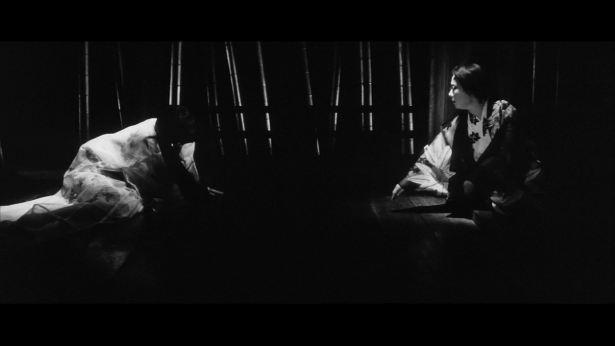
We get to see the women alone in their spirit realm, discussing the situation. Shige wants to reveal herself to Gintoki, and give up her spirit life, but Shige reveals that they made a promise to the god of evil that they would come back to life and kill samurai and drink their blood.
The cinematography in the film is fascinating, but especially in this scene, as the women appear to be in some kind of dark place and spotlights keep hitting them as they move around. It really adds to the spookiness of the film and makes the women feel unnatural.
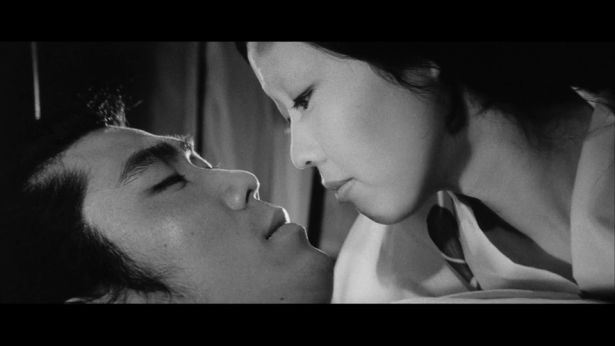
The next time Gintoki visits, they continue with their normal process, but when it comes to the lovemaking, Shige doesn’t kill him, but just enjoys it. He continues to come back, remarking on how similar her body is to his wife’s body. These scenes are incredibly sensual, and even sexy. These are love scenes in the truest sense. These two people love each other.
Gintoki is summoned to Raiko, who is unimpressed with his progress. When Gintoki tells him that it is a spirit killing the samurai, Raiko asks why he hasn’t killed it. Gintoki returns, but finds only Yone. He asks for Shige, but she tells him that she is gone forever. Because she didn’t kill him, she broke her promise to the god of evil to kill samurai, and was sent to hell. It’s only Yone left. Gintoki is of course heartbroken. He asks Yone directly if she is his mother, but she says she is bound by a vow to the god of evil not to reveal their identities. Gintoki never fully understands what happened to his wife and mother, but we can see in this scene that he’s beginning to piece it together.

The killings continue, and Gintoki is told by Raiko that he can either solve the problem, or be killed himself. He returns to his mother, and tells her his situation. She tells him that if he comes with her to read a sutra with her, she will follow Shige into hell. He agrees, but realizes she isn’t sincere, and attacks. In the fight, Gintoki manages to cut off her arm, which immediately devolves into a large black cat paw.
When he returns to Raiko, he is told he must go through a purification process to ensure the spirit is dead. He sequesters himself in a room all by himself for seven days and seven nights. As he sits, he hears the ghost of his mother begging to be let in. The arm he cut off is her weapon, and without it, she cannot cause anymore harm. He refuses.

But on the final day, we learn how dumb Gintoki actually is. He hears a voice of a woman asking to be let in to cleanse the room of spirits. She claims she is from the emperor. He is swayed by her insistence that she comes from the emperor and lets her in.
Of course, this is the spirit, setting up the final confrontation. I’ll leave it open who wins, but the film has made it clear that one of them has to die.
House (1977)
A high school girl named Gorgeous goes to visit her aunt’s home in the countryside on a school break. Her group of friends decides to go with her and they all make the trek. But when they get there, they start noticing strange things about the aunt, her home and her cat. When the girls start getting picked off one by one, will any of them survive the night?

The film is directed by Nobuhiko Obayashi and stars a group of young actors who have had nice careers, but not things that would be familiar to American audiences, much like that last film. There is also an American film called House, which is also a haunted house story(and spawned a series of b-movie sequels), but as far as I can tell, the films don’t share any connection other than the title. There is also an American medical drama called House, but I’m definitely certain that isn’t related.
The important thing to note about this film is that it is completely bonkers. It constantly switches styles and settings, leaving the audience never sure what’s coming up next. We initially get highly realistic sets, but then when moving to Gorgeous’ home, we see an idyllic painted skyline behind her home with heavily saturated colors. When her new stepmother appears, she is in slow-motion soft focus, with silky scarves flowing around her. When the girls arrive at the bus stop in the aunt’s village, they stand in front of a fake backdrop before walking a bit to the left into a completely different open field.

But the first thing the film does to tell us things are going to get weird is from the character’s names. The girls are named Gorgeous, Fantasy, Mac, Prof, Kung Fu, Melody and Sweet. They are each named after their personality. Gorgeous is…gorgeous. Fantasy keeps letting herself be carried off into fantasies. Mac overeats. Prof wears glasses, and is smart. Kung Fu keeps kicking everything. Melody plays piano, and Sweet is…sweet. We might think that these are just exaggerations from the English translation, but I can read Japanese characters, and at one point the film gives each girl her own title card, and while some of them are translated differently, most of the girls are named exactly what their English names sound like. It’s bizarre, but it really works for the film.
The plot is set into motion after Gorgeous meets her new stepmother for the first time. Her father introduces her, and we see how much she cared for her mother, who died many years before. She has a heartfelt conversation with her picture, and we see some of their relationship in this scene. For a goofy horror film, it really works well. She decides to go and visit her aunt, her mother’s sister instead of going with her father on vacation. Her friends were planning on going somewhere else, but they agree to join her, and they all go off together.
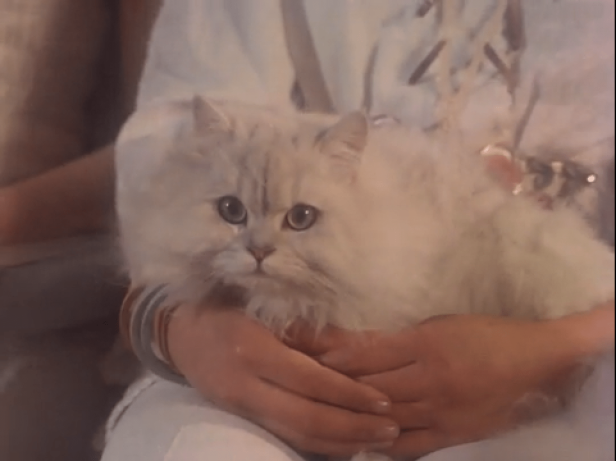
This film also features a cat, this one a white cat, which Gorgeous dubs Blanche. Now when they call out the cats name, they say “Shiro”, which just means ‘white’ in Japanese, but the translators took a bit of liberty here to find a better English name for that cat. The cat appears to Gorgeous while she is struggling with her new stepmother, and it seems to have some suggestive power over her. She writes the letter, and the cat is sitting on the mailbox when the return letter appears. We also see later that it injures Mr. Togo, a teacher who is supposed to chaperone them on the trip. Blanche is clearly some kind of familiar for the aunt, or possibly even a form she can leave the home in.
The girls make their way to the small village, and on the way, Gorgeous tells them the story of her aunt’s life. This portion of the film plays out like a silent film, and the girls comment over it as if they were watching it. Another bizarre moment, but nothing like what we’ll see later. We learn that her aunt was engaged before the war, and her fiancee was killed in a plane crash after enlisting. She never married, living in her house, mourning her lost love. The girls all find that very romantic.

When they arrive at the train station, they have a long way to go, getting on a bus, and then taking a long walk. When they get to the home, it looks run down, and the aunt is in a wheelchair. She looks elderly. She tells them that she lives alone, and invites them in.
We get our first taste of Kung Fu’s abilities, as a crystal falls from a chandelier, and she springs into action. She has her own theme music, and she kicks the crystal away, killing a small lizard crawling around. The girls begin to prepare dinner, and Mac goes to retrieve a watermelon that she sunk in the well to cool it down. When she doesn’t come back, Fantasy goes to check on her, and we get our first major horror scene.

Fantasy doesn’t see Mac, but when she pulls the rope that the watermelon was attached to, what she finds is Mac’s head. And it’s not dead at all, but alive, and speaking. It attacks her, biting her on the ass before she runs for her life screaming. When the other girls go out to check, they just find the watermelon on the rope. They all dismiss Fantasy. While they share the watermelon, she watches Auntie, who seems particularly satisfied. She looks at Fantasy and winks, opening her mouth, revealing an eye there. But still, no one else notices.
Sweet is the next to disappear. She searches for bedding, and follows the cat through a door it has opened. Earlier in the film, the girls mention that “Any old cat can open a door, but only a witch cat can close one.” I don’t know if this is a Japanese proverb, but it’s an interesting phrase, and we see it happen here. The cat closes the door behind her, and while Sweet stares at a small doll, she is attacked, and we lose sight of her.
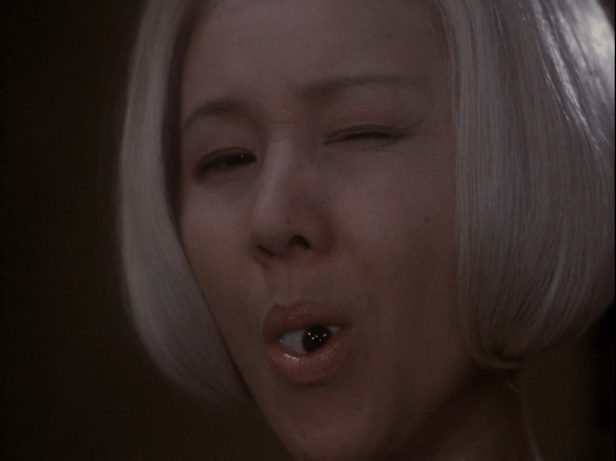
When we next see the aunt, she seems to be in much better condition. She’s walking around, even dancing. She continues to tease Fantasy, ducking into the refrigerator. When she opens the door, she’s gone. She’s moved onto the roof, and looks directly into the camera. We also get a brief scene of her eating one of the girls hands.
As the film goes on, things just get more and more insane. Gorgeous discovers her aunts makeup, and begins to try it on, seeing her aunt’s face in the mirror, and then burning up. Melody plays the piano downstairs and the keyboard lights up, and she can’t seem to stop playing.
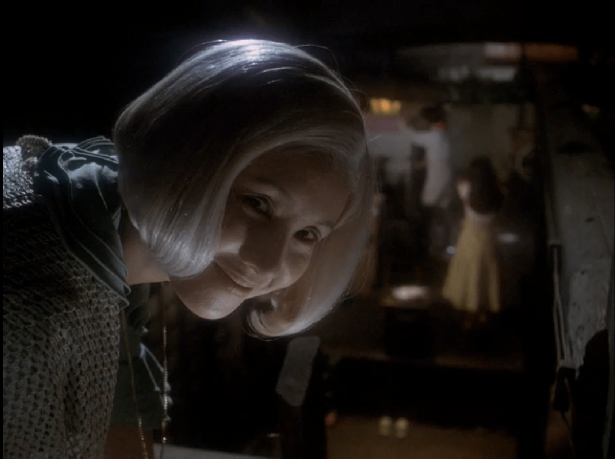
When we next see Gorgeous, she appears to be out of it. The other girls have convinced her to call the police. She tries, but claims that the phone is out of order. She offers to walk there herself. At this point, it’s clear that Gorgeous is no longer herself. She has been taken over by the aunt.
Only Fantasy, Prof, Melody and Kung Fu are left. The film moves towards it’s climax, as the girls find the remains of Sweet, trapped in a bleeding clock, and the Kung Fu begins fighting the house. Melody is drawn to the piano again, and this time, the piano begins to eat her. First her fingers, then it consumes the rest of her.

Prof finds a diary of Auntie, and begins to read it. They learn that Auntie died years before, but remained as a demon that gained power through eating unmarried women. They eventually decide that the cat is the source of her power and try to destroy an image of it on the wall. Kung Fu jumps in, but is attacked and consumed by a light fixture. But her legs, separated from the rest of her body fly out of the light fixture and attack the picture, which begins spewing blood. The house turns into a lake and Prof and Fantasy float on a floorboard.
Prof falls off, and Fantasy floats over to Gorgeous, dry and safe on the stairs. Fantasy finally succumbs, embracing the monster.
In the final scenes of the film, Ryoko, Gorgeous’ new stepmother comes to visit, planning to show Gorgeous that she cares. When she arrives, she only finds Gorgeous, who tells her that her friends will be hungry when she wakes up.
The Double Feature
Here we have two horror films, with very different tones. Kuroneko is dark and moody, House is gory and goofy. But they also have some things in common. Besides involving cats as the main villain, both films end without the monster being destroyed. In Kuroneko, Yone defeats her son, and we must assume continues killing samurai. In House, Auntie completes her goal of taking over Gorgeous’ body, and it’s clear that Gorgeous intends to continue killing, starting with her new stepmother, who is engaged to her father, but again, not married.
Both are interesting from a subtle political perspective as well. Kuroneko reminds me a bit of an exploitation film called Ms. 45, in which a woman who is raped begins a crime spree murdering men. In Kuroneko, two women are deeply wronged and dedicate their lives to punishing them for their crimes. Shige is portrayed as the weak woman who forgives everything as soon as her man returns. For this she is punished by being sent to hell. But Yone remains strong, willing to sacrifice her own son to ensure that she is able to continue her mission.
Conversely, in House, Auntie is furious that she was deprived of her happy life with a husband. Because of this, she punishes young women who have not gotten married. She sees marriage as the ultimate goal for any woman. Further, the young women who are her victims cannot stand up to her. Short of Kung Fu and Prof, none of them have any skills that can be useful in this situation. And both of them are easily defeated. They are reduced to tropes, rather than characters. Each of them has a single personality trait. They are by definition one-dimensional. I’m not sure if Obayashi intended this as a critique of women’s roles in films, but I’m sure someone who studied the feminist angle of film could dig deep into this.
Both films are amazing, and must-see for any horror fan or film fan.
Reflection
I am still in Amsterdam, and I’m enjoying my time here. I am getting so spoiled by a functional public transit system. It really is wonderful just hopping on a train and taking a quick ride to the next city over, being there for the day, and then hopping right back. There’s a lot to be said for the freedom of owning a car and driving, but in most cases, I think I’d much prefer just riding public transport if it was a viable option.
Looking at next week’s films, I’m going to stick with horror, but next week, I’ll be covering a couple that I’ve never seen before.
Brian De Palma – Sisters (1973)
David Cronenberg – The Brood (1979)
I’ve seen various films from both directors over the years, but I’ve never considered myself a serious fan of either. But I’m looking forward to these two films.
See you then.
